
|
 |
Gourmet News Archives
July 2005
7.25.05
Specialty Chocolatiers Bridge the Gap Between Regular and Diet Candy. Sales of sugar-free, low-sugar, and low-fat candies in the U.S. quadrupled between 2000 and 2004. Demanded by diabetics and dieters, last year consumers bought an estimated $495 million in diet candy, compared with $118 million four years earlier, according to Packaged Facts, a division of MarketResearch.com. The overall candy market has grown just 1% to 2% per year.
Leading the growth are huge companies like Russell Stover and Hersheys, which have developed better artificial sweetener blends to make diet versions of their popular candies that have been adopted by mass audiences. However, there is still a noticeable gap in taste between the regular and diet versions. Specialty food manufacturers, on the other hand, use the finest ingredients available and as a result have created fine chocolates that can pass for “the real thing.”
|
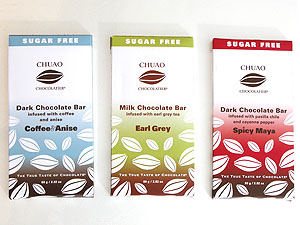 |
| Chuao Chocolatier’s sugar-free chocolate bars taste as good as the “real thing.” From left to right: Coffee and Anise Bar in dark chocolate, Earl Grey Bar in milk chocolate, and Spicy Maya Bar, which combines the flavors of Pasilla chile, cayenne Pepper and cinnamon in dark chocolate. |
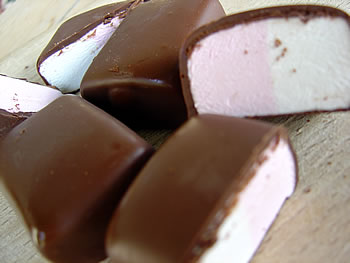 |
| La Nouba’s pink and white sugar-free marshmallows are available plain and covered in Callebaut chocolate. |
Chuao Chocolatier, a prestige chocolatier in Encinitas, CA, near San Diego, uses maltitol to create sugar-free versions of of its regular flavored bars, with spectacular results. You wouldn’t know there was no sugar in these delicious bars, which are made with El Rey Venezuelan chocolate, one of the finest couvertures in the world. La Nouba, a Belgian company that produces only a line of products with maltitol, uses Callebaut couverture to create a group of bars that include dark, milk and white chocolate bars plus infused coconut, mint, and raspberry milk chocolate; as well as dark bars filled with coconut, lemon, orange, or vanilla cream. Their sugar-free marshmallows taste even better than most made with sugar (click here for our review). VereGoods will debut a line of beautiful bonbons and truffles in September that are low glycemic, high fiber, and all natural—no artificial sweeteners—made of top quality Plantations™ Arriba chocolate from Ecuador.
Look for more excitement, in both prestige and mass brands. “It’s a very untapped market and as we see innovations in that market we’re going to see more interest as well,” said Susan Fussell, a spokeswoman for the National Confectioners Association.
Terra Chips Celebrate Six Tons. If you’re a foodie, chances are you’re familiar with the alluring black and silver bag of Terra Chips, which have been available nationwide since the company was bought by the Hain-Celestial Group, a large natural and organic products company, in 1998. The chips were created in 1990 when Dana Sinkler and Alexander Dzieduszycki, chefs who worked at one of Jean-Georges Vongerichten’s New York restaurants, left to form a catering business.
|
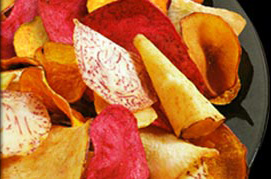 |
| Beets didn’t work in the Terra Chips assortment, but beet juice lends a glorious color to taro chips. |
They served the exotic root vegetable chips to their high-end clientele; Saks Fifth Avenue saw them and asked to sell them. What began as two partners cooking chips in a home kitchen in Brooklyn is now a 100 person operation, processing 40 million pounds of raw vegetables annually into 18 million pounds of Terra Chips. (A second plant in Washington State produces Terra’s line of potato chips.) After initial experiments which saw the departure of celeriac and lotus root, today’s mix was finalized: yucca, taro, taro colored with beet juice, parsnip, sweet potato and batata, a sweet potato-like root.
Click here for recipes using Terra Chips as the base for creative hors d’oeuvres, as crusts for meats and seafood, in stuffings and more.
OJ in a Slump. Officials at the Florida Department of Citrus are concerned about a 5.9% decline in orange juice sales across the northeastern United States. The biggest markets, from Pennsylvania and New York through New England, are in decline.
Based on sales figures reported by AC Nielsen, a Chicago marketing firm, the Northeast market sold 3.1 million fewer gallons of orange juice in the period from October 2004 through May 14, 2005. Compared to the Northeast slump of 5.9%, sales in the Southeast and Midwest were flat for that period and the western market experienced a 4.2 percent growth.
|
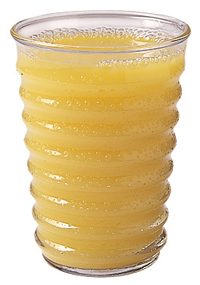 |
| Photo courtesy of 5aDay.gov. |
Bob Norberg, director of market and economic research for the Florida Citrus Commission, suggested the rising price of not-from-concentrate (NFC) orange juice products as a factor. The major brands also are not discounting NFC orange juice as much as they have previously, he said. NFC orange juice accounts for a larger share of the Northeast than the other regions, Norberg said. Following research into the problem, expect an advertising campaign encouraging us to DRINK MORE ORANGE JUICE.
7.18.05
Specialty Food Spectacular. The annual Summer Fancy Food Show took place last week. The intrepid Nibble staff joined 24,000 other buyers and journalists to pour over 100,000 products on exhibit. You can check out our top picks of the show here.
What’s In Your Coffee Room? Good coffee is important to so many people that it just may become the next office perk. The Washington Post reported last week that an increasing number of offices are now providing gourmet coffee brewed on high-end professional coffee machines to their employees. Other offices use coffee clubs that split the costs among employees who care about such fine coffee.
The finance chief of one company providing free Starbucks said the increased cost of the coffee is offset improved productivity as employees don’t make 40-minute round trips to the nearest Starbucks. An employee at the firm said that getting the Starbucks coffee was like receiving a raise, since she had been spending between $6 to $12 a day of her own money at Starbucks. |
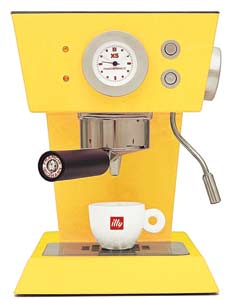 |
| For your office coffee club: Illy offers the Francis!Francis! V espresso machine with a monthly shipment of Illy espresso. |
But Starbucks is the bargain brand compared to one office coffee club, where each member contributes a pound of high-end coffee each month. One of the coffees enjoyed by members is a $28-a-pound brand of coffee that is grown in Lehuula Farms in Kealakekau, Hawaii, and air freighted the day after it is roasted. It’s brewed in the club’s $800 machine. But another company has two $1,400 Italian espresso makers in its coffee room: the second is a back-up for when the first needs servicing.
According to the publication Automatic Merchandiser office coffee service nationwide is a $3.4-billion a-year business and growing. It will grow even more when they start offering the $28-a-pound good stuff instead of the O.K. beans usually on the menu.
Sofas, Lamps, Roll-mops & Elk. Furniture retailer Ikea will launch its own label of food products next year across its stores worldwide. Ikea plans to offer mainly Swedish delicacies, such as roll-mop herring and smoked elk sausage, which will appeal to consumers interested in specialty foods. Industry analyst Datamonitor believes the Ikea food brand launch will be successful given the retailer’s high profile among consumers and the growth of the specialty foods market.
Ikea has been selling food since the 1980s, when it launched in-store restaurants and began selling some food products. The restaurants are successful and the company’s food markets division now stocks about 150 products, most of them from Sweden. Currently, only 10% carry the Ikea name. But the new line will be 30% Ikea-branded. Ikea hopes to leverage its restaurants to showcase foods it will sell in the store. About half of Ikea’s customers visit the restaurants.
Bittersweet Boom. The Chocolate Manufacturers Association reports that domestic sales of gourmet dark chocolate (the industry term for high-end chocolate is prestige) rose 17 percent last year. Retail sales of all chocolate rose 3.9 percent to $15.1 billion, compared to a 2.3-percent increase for candy in general. The numbers reflect increasing connoisseurship of chocolate, and the number of boutique chocolatiers who are creating chocolates of fine cacaos, developing original recipes and fusion flavors like Chipotle, Earl Grey and Chinese Five Spice. Our Chocolate Section contains a wealth of information about fine chocolate, including Chocolate 101: Understanding Prestige Chocolate.
7.11.05
Talking Wine Bottles. Reuters reported last week that Modulgraf, a company in the Tuscany region of Italy, is developing a chip-implanted wine label that will “talk” to consumers about the wine. The chip will enable the winemaker, store, or restaurant to tell consumers everything they want to know about a particular bottle—for example, production details, peak drinking years and food matches. The product is expected to launch in November. The technology consists of a chip implanted in the bottle and a small receiver the size of a cigarette package on which the consumer would listen to the information. It sounds not unlike systems at some museums, where the chip gives details on a painting when a visitor stands in front of it. While conceptually this can be helpful, hopefully the manufacturers are planning an earpiece to deliver the sound. Otherwise, stores and restaurants could turn into towers of wine babel that make cell phone talkers see benign.
Asking For The Water List. Speaking of restaurants, bottled water is just emerging as part of the fine dining experience in the United States. Today 25%-40% of the bottled water sold in the U.S. is actually bottled tap water, according to government and industry estimates. Fine water is currently transitioning from being treated as a commodity product, i.e. bottled tap water, to being seen a natural product with a unique source. There are many brands available, and many fine restaurants offer water lists for connoisseurs to chose from. FineWaters.com, a website for water connoisseurs, lists more than 500 brands from 21 countries and in a conservative estimate the total number of bottled water brands today on a world wide basis is close to 3,000. Italy alone has more then 600 brands.
Rooibos Now in Public Domain. After ten years and spending nearly $1 million in legal fees, Rooibos Ltd. has reached a settlement agreement with Burke-Watkins and Forever Young Limited over the rights to the use of the generic term “rooibos.” Under the settlement agreement’s terms, the latter two parties have voluntarily and unconditionally agreed to cancel their registration of the word 'rooibos' in the USA and various other countries.
|
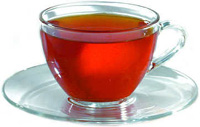 |
| A cup of brewed rooibos tea. |
Rooibos (pronounced “roy-boss”) is a caffeine-free herbal tea grown exclusively in South Africa's Cedarberg area that provides great taste and delicate flavor, as well as the numerous documented health benefits of its polyphenols and antioxidants, which may delay the aging process, plus help protect against heart attacks, strokes, and certain cancers. It has been consumed as a tea in South Africa for well over 100 years and marketed internationally during most of that time.
In 1994, Forever Young (Pty) Limited registered the name “rooibos” in the U.S. and numerous other countries in an attempt to restrict the use of the name to those willing to do business with Forever Young. In 2001, Forever Young assigned the registration of “roy-boss” to Virginia Burke-Watkins of Dallas, Texas. As a result, many companies who used rooibos individually or in formulations had to create alternative names, such as Red Tea and Red Bush, which confused tea drinkers. In spite of the registered name obstacle, Rooibos sales in the U.S. have quadrupled every year since 1999.
Brazilian: The Next Food Trend? The next big thing in ethnic foods may be the cuisine of choice of the Girl from Ipanema. Brazilian cuisine is trending up, according to Productscan Online. Although few are predicting that Brazilian is going to replace Mexican anytime soon as Americans’ favorite south-of-the-border cuisine, a steady growth of consumption of Brazilian foods and beverages suggests that Brazil may be in the formative stages of becoming our next food fashion. Brazil’s number one beer, Brahma Beer, is being launched in the U.S.; while Cachaca, a white spirit product from sugar cane, is already popular in trendy bars and restaurants (it is the key ingredient in the caipirinha, a traditional cocktail that has become increasingly popular). Guarana is used in foods from energy drinks to yogurt to chocolate bars. And more churrascaria-style steakhouse restaurants are surfacing, serving a variety of grilled meats and salads. Keep a watch out in your neighborhood.
|
A berry that grows in Venezuela and northern Brazil, Guarana is named after the Guarani tribe of Brazil. Both were discovered by German medical botanist C.F. Paullini in the 18th century. The taste of Guarana is distinctive and unique, and the main reason for its success in Brazil as a soft drink. The main ingredient of guarana, guaranine, is chemically identical to caffeine; which is why it provides an energy boost. Photo courtesy of Tealand.com.
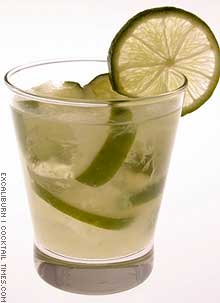
Caipirinha, courtesy of CocktailTimes.com.
|
7.4.05
Foods For Thought on Independence Day. An article on MSN.com names ten foods that “made America great.” Noticeably absent, because it evidently is not as American as apple pie, is the apple pie, which originated in Europe. You can click through to read the full article. The Top 10 choices include:
- Clam chowder (New
England)—reader’s #1 pick
from this list, by a landslide
- Pastrami (New York)
- Shoofly Pie (Pennsylvania)
- Smithfield Ham (Virginia)
- Po-boy Sandwich
(Louisiana)
- Fajitas (Texas)
- Vienna Beef Sausage Hot
Dog With All the
Trimmings (Chicago)
- Chile Verde (New Mexico)
- Sourdough (San Francisco)
- Olympia Oysters
(Washington)
|
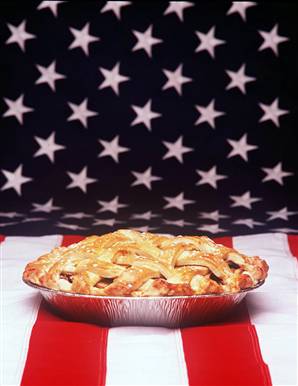 |
Surprise: it’s not as American as apple pie! Photo from Index Stock Imagery.
|
It’s an odd list. Why did hot dogs, the provenance of which is with European charcuterie, get on the list; when apple pie got the boot? And what’s with Chile verde—the chile pepper is an ingredient, not a food in the sense of an edible dish like the other nine. If any ingredient deserves to represent the best of America, it’s maple syrup—which at least, unlike the chile, can be eaten and enjoyed by the spoonful. And with all due respect to Olympia oysters, there are other indigenous species more familiar to Americans—although probably not geographically diverse enough to round out this “national” list.
Still, it’s a most enjoyable article, very educational and beautifully illustrated. And as you’ll see from reader write-ins, there is plenty of material for a completely different list for next year.
Bacon For Dessert. An item in the Pastry Scoop newsletter—read by pastry chefs—suggest ways to use America’s favorite breakfast meat as a dessert. Sound strange? Although an unconventional choice, bacon, with its salty, smoky, almost sweet flavor, bacon is a natural fit with sweets (remember bacon-wrapped prune hors d’oeuvres?).
Here’s what some of creative pastry chefs are turning out:
|
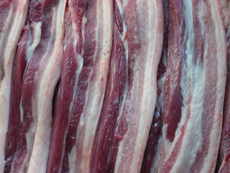 |
| Bringing home the bacon. Photography courtesy of the National Pork Board. |
- Phoebe Lawless of Magnolia Grill in Durham, North Carolina combines bacon with peanut butter and chocolate into a sweet-meets-salty truffle.
- Nicole Kaplan at New York City’s Eleven Madison Park served up apple spice cake with cheddar bacon crumble and maple pecan ice cream on her fall menu.
- Carina Ahlin of New York City’s Aquavit pairs Pierre Robert, a triple crème cheese, with roasted pear and bacon caramel for an elegant breakfast meets cheese course for dessert.
How would you use bacon in a dessert? Click here to let us know, and maybe we’ll do an article of bacon dessert recipes so we can all enjoy them.
One (Wo)Man, One Vote. Americans went to the polls again...to vote for the best beer in America. The poll, conducted by RateBeer.com, claims to be the world’s largest: consumers from more than 65 countries voted, and more than 30,000 different beers from over 4,000 brewers were eligible.
Like politics, beer is a local matter: two-thirds of the brewers judged the best by Americans, the vast majority of voters, were made in the U.S.A. The survey showed what beer lovers already know: that there are quality beers almost everywhere in the country. Only the South came up short: no company there made it onto RateBeer’s Top 50 list. (And in many states in Old Dixie, it’s a challenge to find any beer besides the mass-marketed varieties.)
Heading he Top 50 are:
- AleSmith Brewing Company, San Diego, CA USA
- Three Floyds Brewing Company, Munster, IN USA
- Stone Brewing Company, San Diego, CA USA
- Westvleteren Abdij St. Sixtus, Westvleteren, Belgium
- Hair of the Dog Brewing Co., Portland, OR USA
- De Dolle Brouwers, Diksmuide, Belgium
- Kalamazoo Brewing Company, Kalamazoo, MI USA\
- Pizza Port (Solana Beach), Solana Beach, CA USA
- Dogfish Head Brewery, Milton, DE USA
- Fuller, Smith & Turner, London, England
Click here for the full list of winners.
The editors vote twice: for their favorite everyday All-American and for their hometown hero. |
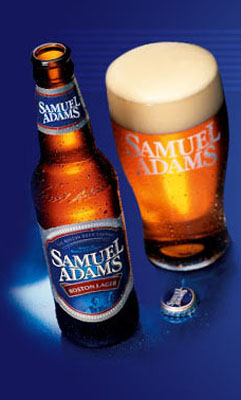
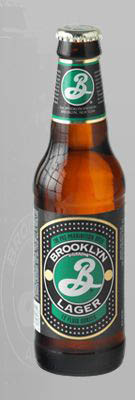 |
Green Tea Not Helpful With Two Major Cancers. On June 30th the FDA issued a report for consumers discussing claims that green tea may reduce the risk of breast and prostate cancer.
Based on a systematic evaluation of the available scientific data, the FDA intends to consider exercising its enforcement discretion for the following qualified health claims: |
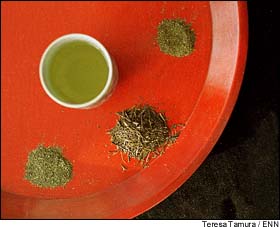 |
- “Two studies do not show that drinking green tea reduces the risk of breast cancer in women, but one weaker, more limited study suggests that drinking green tea may reduce this risk. Based on these studies, FDA concludes that it is highly unlikely that green tea reduces the risk of breast cancer”; and
- “One weak and limited study does not show that drinking green tea reduces the risk of prostate cancer, but another weak and limited study suggests that drinking green tea may reduce this risk. Based on these studies, FDA concludes that it is highly unlikely that green tea reduces the risk of prostate cancer.”
The FDA also concluded that existing evidence does not support qualified health claims for green tea consumption and a reduced risk of any other type of cancer. The FDA will continue to evaluate new information that becomes available to determine whether changes in these claims, or in the decision, are necessary.
Lifestyle Direct Direct, Inc. All rights reserved. Images are the copyright of their respective owners.

|




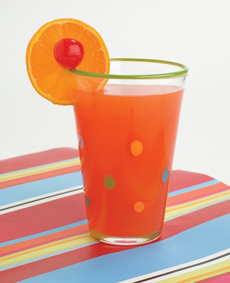 The nectars of summer taste even better in Tutti Frutti glassware by Ginger Kelly, from
The nectars of summer taste even better in Tutti Frutti glassware by Ginger Kelly, from 









